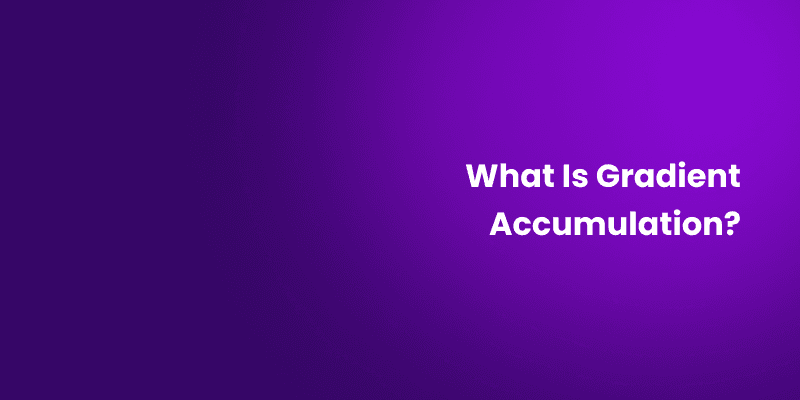
Training large language models (LLMs) like GPT or LLaMA requires immense computing power. Often, hardware limitations prevent using large batch sizes during training, which can slow down or reduce the quality of the training process. One technique that helps overcome this challenge is Gradient Accumulation.
In this article, we’ll explore what gradient accumulation is, how it works, and how it can be used in large language models to optimize training without requiring high-end hardware.
What Is Gradient Accumulation?
In simple terms, Gradient Accumulation is a method used during model training to simulate larger batch sizes when the hardware (like GPUs or TPUs) can’t handle them. Instead of updating the model's weights after every batch of data (which is typical in training), gradient accumulation collects or "accumulates" gradients over multiple smaller batches and updates the model only after a certain number of these batches.
Why Is Gradient Accumulation Important?
When training LLMs, using larger batch sizes typically leads to better model performance. However, not all machines can handle large batches because of limited memory. Gradient accumulation addresses this problem by allowing the model to behave as though it’s training on large batches without requiring all the data to fit in memory at once.
Here’s why gradient accumulation is useful:
.png&w=1920&q=75)
Overcomes Hardware Limitations: Even if you have limited GPU memory, gradient accumulation lets you effectively use larger batch sizes.
Improves Model Training: Larger batch sizes usually lead to smoother and more stable updates during training. By accumulating gradients, models benefit from these larger virtual batches.
Reduces Costs: You don’t need the most powerful (and expensive) hardware to train large models. Gradient accumulation allows training on smaller, more affordable machines without sacrificing performance.
How Does Gradient Accumulation Work?
To understand gradient accumulation, let’s break it down into simple steps:
.png&w=1920&q=75)
Training in Batches: During typical training, data is divided into small batches. After processing each batch, the model updates its weights based on the computed gradients (a step known as backpropagation).
Accumulating Gradients: In gradient accumulation, instead of updating the weights after every batch, the model stores the gradients temporarily for each batch.
Accumulation Over Multiple Batches: After processing several batches (the number depends on how large the virtual batch size is), the model adds up all the stored gradients and then updates the weights once. This makes it look like the model was training on a single large batch.
Resetting the Gradients: After the update, the stored gradients are reset, and the accumulation process starts again for the next set of batches.
In this way, the model behaves as though it’s using a larger batch size without needing extra memory to process all the data at once.
Using Gradient Accumulation in Large Language Models
When training LLMs, gradient accumulation can be implemented in most deep learning frameworks like PyTorch or TensorFlow. Here’s how you might use it in practice:
Divide the Batch: You first divide your data into smaller mini-batches. Let’s say you want to use a large batch size of 64, but your GPU can only handle 16 at a time. You would divide your batch into four smaller mini-batches of 16.
Accumulate Gradients: As the model processes each mini-batch, the gradients are calculated but not immediately applied to update the model’s weights.
Update After Multiple Mini-Batches: Once four mini-batches are processed (equivalent to the original batch size of 64), the accumulated gradients are combined, and the model’s weights are updated once based on this accumulated information.
Adjust the Learning Rate: Sometimes, when using gradient accumulation, you may need to adjust the learning rate to balance the effect of updating the weights less frequently.
.png&w=1920&q=75)
Advantages of Gradient Accumulation
Gradient accumulation provides several key benefits, especially for training large language models:
Memory Efficiency: By using smaller batches and accumulating gradients, you reduce the memory load on your hardware, making it possible to train large models even on less powerful machines.
Cost-Effective: Training large models on high-end GPUs can be expensive. Gradient accumulation allows you to make the most out of more affordable hardware, reducing overall costs.
Better Training Stability: Large batch sizes lead to more stable training. Accumulating gradients mimics this effect, providing the stability of large batch training without the need for more memory.
Flexibility in Model Training: You don’t need to be constrained by your hardware. With gradient accumulation, you can still experiment with large language models without needing cutting-edge resources.
Challenges and Limitations of Gradient Accumulation
While gradient accumulation offers several benefits, there are also some challenges and limitations to consider:
1. Slower Convergence
Because the model only updates its weights after processing multiple mini-batches, it might take longer for the model to converge (reach its optimal state). The training process could be slower compared to using actual large batches if not managed carefully.
2. Potential for Overfitting
Using gradient accumulation could lead to overfitting if not properly tuned, especially if combined with smaller datasets. The model might get too specific to the training data, losing its generalization capability.
3. Complexity in Implementation
Setting up gradient accumulation can be more complex than traditional training, as it requires fine-tuning various parameters like the learning rate, number of accumulation steps, and batch sizes. Incorrect settings could result in inefficient training or worse performance.
4. Compatibility with Optimizers
Not all optimization algorithms are well-suited for gradient accumulation. Some optimizers, like Adam, may need additional adjustments to work effectively with gradient accumulation.
Conclusion
Gradient accumulation is a powerful tool that helps you train large language models effectively, even when hardware resources are limited. By simulating larger batch sizes, it improves the training process without the need for expensive equipment. However, while it offers many benefits, it’s important to understand its challenges and limitations to use it correctly.
For those working with large language models or deep learning frameworks, gradient accumulation is a practical solution to keep training efficient, cost-effective, and scalable, especially when resources are limited.
